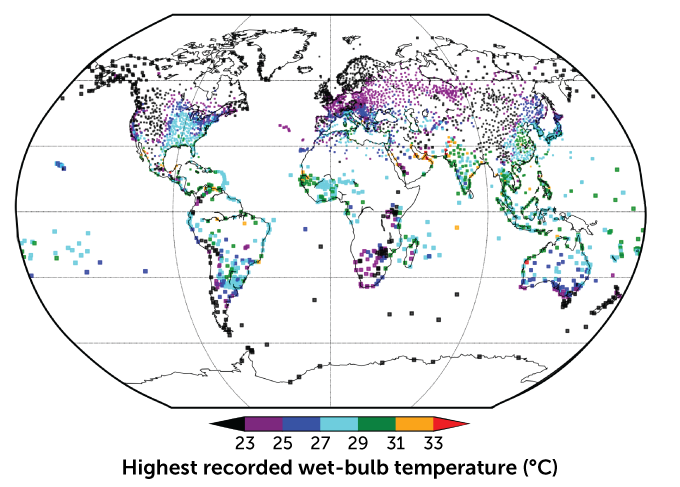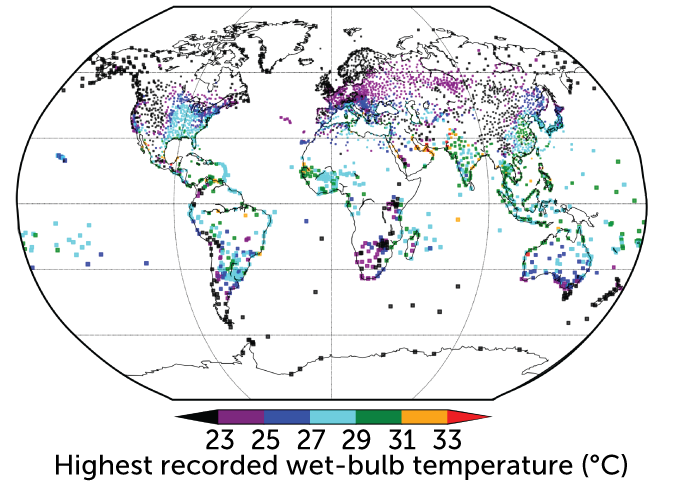
Dangerously high combinations of heat and humidity are already plaguing places like New Delhi (shown), putting outdoor workers at greater risk of heat-related illness or death. New research finds that such extreme events have been increasing over the last 40 years.
ErmakovaElena/iStock Editorial/Getty Images Plus
- More than 2 years ago
Read another version of this article at Science News Explores
Human beings have a superpower — sweating.
When temperatures rise, beads of sweat exude from our pores and evaporate, releasing energy that cools the skin and keeps our bodies from overheating.
This self-cooling mechanism has helped humans spread to every hot and humid corner of the globe. But that sweating superpower has a theoretical upper limit: When it gets too hot and humid, the laws of physics inhibit sweat from cooling skin. That limit is hit when a bulb thermometer wrapped in a wet towel (a measure of heat and humidity known as “wet-bulb” temperature) reads 35° Celsius, or 95° Fahrenheit. Even the fittest human supplied with unlimited water would probably die after a few hours in these conditions.
Scientists have thought that this temperature extreme occurs rarely, if ever, on Earth. But as the globe warms, wet-bulb temperatures around 35° C could become more common toward the end of the century in certain regions, endangering hundreds of millions of people, recent climate simulations suggest (SN: 8/2/17).
It turns out we won’t have to wait that long.
An analysis of global weather station data shows that this human survivability limit has been briefly surpassed at least a dozen times in the last four decades at sites along the Persian Gulf and Indus River Valley in India and Pakistan, researchers report May 8 in Science Advances. Slightly lower, but still dangerous, wet-bulb temperatures are increasingly familiar features of summer across larger swaths of the Middle East, South Asia and the U.S. Gulf Coast, the study shows.
Sign up for our newsletter
We summarize the week's scientific breakthroughs every Thursday.
“We expect these extreme wet-bulb values to be rare, but to become more common as the world warms,” says Matthew Huber, a climate scientist at Purdue University in West Lafayette, Ind., who wasn’t involved in the study. “It’s disturbing to see it happening in real time.”
Researchers have only relatively recently begun using statistical simulations to estimate where and when this extreme moist-heat threshold might be approached or crossed, which could have dire consequences for societies. (SN: 4/3/18). But these models work by simplifying and aggregating weather station data across a region. The fine details often get sacrificed in service of broader trends, potentially obscuring local spots where the temperature threshold is briefly reached.
Those fine details matter to Colin Raymond, a climate scientist at NASA’s Jet Propulsion Laboratory in Pasadena, Calif. Whether temperatures already have reached this physiological limit somewhere on Earth “seems almost to be an essential piece of knowledge for us as a species,” says Raymond, who did the work while at Columbia University.
He and his team scoured data from 4,576 weather stations across the globe, looking for instances of extreme wet-bulb temperatures and tracking trends from 1979 to 2017. After removing measurements that didn’t jibe with nearby stations or seemed like obvious errors, a clear pattern emerged: Extreme wet-bulb temperatures have occurred, mostly along subtropical coasts, where warm, moist air from the ocean collides with hot air on land. In South Asia, such extremes are fueled by monsoon winds.
Too hot spots
Researchers analyzed data from over 4,000 weather stations to determine which regions experience the highest “wet-bulb” temperatures, a measure of heat and humidity. The color of each square represents the highest such temperature recorded at each station from 1979 to 2017. Red represents a mix of heat and humidity that is close to or at the threshold at which human bodies can no longer handle the temperature for an extended period of time.
Maximum humid heat, or ‘wet-bulb’, measurements, 1979–2017


Temperatures at or beyond that physiological limit were rare and confined to an hour or two at hot spots along the Persian Gulf, such as a weather station at the Abu Dhabi International Airport in the United Arab Emirates. Nearly 1.5 million people live in Abu Dhabi. (An interactive map created by the researchers plots the highest wet-bulb temperatures recorded at stations across the world.)
The team also documented wet-bulb temperatures of 33° C, which roughly translates to a heat index of 60° C or 139° F. (The heat index, or what a temperature feels like with humidity, isn’t designed to go this high, so comparisons are rough.) That temperature is just shy of the physiological limit but still “much hotter and more humid than many of us have experienced,” Raymond says. The analysis found that 40 years ago, these events happened once or twice a year on Earth. But now, such oppressive moist-heat events happen 25 to 30 times a year. “There is a doubling or more of these extreme events over four decades,” he says.
So are the simulations predicting that these temperatures wouldn’t arrive until midcentury wrong?
Not necessarily, says Joy Merwin Monteiro, a climate scientist at the Indian Institute of Science Education and Research in Pune, who wasn’t involved in the study. “Models are too coarse to give a clear picture of what’s happening at these finer spatial and temporal scales.” Monteiro says that complementing existing models with more detailed, on-the-ground data is long overdue.
If carbon emissions aren’t drastically curbed in the coming decades, these relatively rare extremes will become increasingly common, researchers say. Such conditions are unbearable without technology like air conditioning and make outdoor labor near impossible.
“We may have to rethink how to live in a place that’s experiencing conditions outside of what we’ve evolved to experience,” Raymond says. “Living in the Persian Gulf in the summer may come to resemble living at the South Pole in the winter.”






